![]()
![]()
![]()
기존 곡선을 편집하거나 스케치 요소 또는 곡선을 선택하여 새 곡선을 생성하여 단순화된 근사치를 적용하고, 차수를 높이고, 제어 곡선 꼭지점을 재배치하거나, 2D 평면으로 평면화합니다.
곡선 편집을 사용하면 곡선에 의존하는 다운스트림 피처와의 연관성을 유지하면서 곡선을 편집할 수 있습니다. 이렇게 하면 모델링 체인 상위의 잘못된 곡선으로 인해 발생하는 모든 표면을 수정할 수 있습니다. 예를 들어, 로프트로 인해 표면이 불량한 경우 로프트의 기준으로 사용된 원래 곡선을 편집하면 더 나은 표면을 얻을 수 있습니다.
곡선 편집 피처를 사용하여 다음을 수행할 수 있습니다.
-
가져온 곡선 지오메트리를 개선하여 평활하고, 균일하고, 재구성하고, 매개변수화하고, 근사치를 다시 계산할 수 있습니다.
-
제어점을 통해 기존 곡선의 모양을 편집합니다.
-
곡선의 제어점을 다른 형상을 참조하여 배치합니다. 예를 들어, 크로스바의 대체 크기 구성이 여러 개 있고 다른 파트의 곡선이 크로스바에 대한 정렬을 업데이트하도록 하려는 경우를 예로 들 수 있습니다.
-
곡선의 각도를 높여 원하는 각도와 일치시키거나, 연결성을 개선하거나, 곡선의 모양을 더 세밀하게 제어할 수 있습니다.
-
곡선에서 원하지 않는 비틀림/뒤틀림이 발생하는 것을 수정하십시오. 곡선과 그 제어점이 선택한 평면 또는 메이트 커넥터로 이동하여 곡선을 직선화 (평면화) 합니다.
곡선은 복잡한 로프트 및 경계 표면의 안내 곡선이나 스윕 경로 등 복잡한 3D 형상의 기초를 제공하는 데 주로 사용됩니다. 경우에 따라 이러한 곡선을 원하는 설계 의도에 맞게 조정해야 할 수도 있습니다. 이러한 경우 Onshape의 곡선 편집 기능을 사용하면 곡선에 종속된 다운스트림 피처와의 연관성을 유지하면서 곡선을 수정할 수 있습니다. 예를 들어, 커브에 원치 않는 비틀림이 있어 로프트 피처의 모양에 영향을 줄 수 있습니다. 곡선을 편집하여 비틀기를 부드럽게 하면 로프트가 더 부드러워집니다.
곡선 편집 기능은 커브를 재생성하고, 곡선의 형태를 조정하고, 다양한 기본 또는 가져온 소스의 곡선으로 작업하기 위한 여러 옵션을 제공합니다.
또한 곡선 편집 기능을 사용하여 각도, 제어점 수 및 범위 수에 대한 읽기 전용 곡선 값을 표시하거나 숨길 수 있습니다.
곡선의 근사값을 다시 측정하려면 근사치를 선택합니다. 이렇게 하면 곡선이 새로운 수학 사양으로 다시 작성됩니다. 목표 각도, 최대 제어점 수 및 허용오차를 설정합니다. 곡선의 양쪽 끝에서 곡선의 접선을 보존하려면 시작 도함수 유지 및 끝 도함수 유지를 선택합니다.
곡선의 새 목표 각도를 제공하려면 상승을 선택합니다. 이 옵션은 곡선을 한층 더 높은 수준으로 올려서 제어점의 수를 늘려 곡선의 모양을 더 세밀하게 제어할 수 있게 합니다.
현재 위치에서 선택한 참조 평면에 곡선의 제어점을 투영하려면 평면화를 선택합니다. Onshape 프로젝트가 제어점을 투영하는 면을 결정하는 데는 여러 가지 옵션이 있습니다. 최적 맞춤 프로젝트는 모든 제어점 위치의 평균을 사용하여 곡선의 경로와 가장 일치하는 면에 제어점을 투영합니다. 곡선의 끝을 원래 위치에 고정하려면 끝 잠금을 선택합니다. YZ, XZ, XY 평면은 제어점을 각 면에 투영합니다. 사용자 정의 프로젝트는 선택한 평면 또는 메이트 커넥터가 제공하는 평면에 제어점을 투영합니다. 메이트 커넥터 아이콘을 선택하여 암시적 또는 명시적 메이트 커넥터 선택을 활성화합니다.
선택한 곡선에서 개별 제어점의 위치와 가중치를 수정하려면 제어점 편집을 선택합니다. 초기 제어점 지수는 곡선의 첫 번째 제어점에 해당하는 0입니다. 인덱스 번호를 입력하거나 그래픽 영역에서 적절한 제어점을 선택하여 추가 제어점을 선택합니다. 제어점을 선택한 후 점 재지정 추가를 클릭하여 오프셋과 가중치 값을 수동으로 입력하거나 그래픽 영역의 3축 매니퓰레이터를 사용하여 위치를 조정합니다. 기본적으로 이러한 오프셋은 원래 제어점 위치를 기준으로 하지만 선택적 참조를 제공하면 특정 점으로부터 오프셋할 수 있습니다. 가중치는 곡선에 대한 제어점의 가중치를 결정합니다. 가중치가 클수록 제어점에 곡선이 더 많이 그려집니다. 가중치는 곡선에서 점이 미치는 영향을 입력한 값으로 곱합니다.
대화상자 작업 순서는 위에서 아래로(근사치에서 상승, 평면화, 마지막으로 제어점 편집) 계층적입니다. 이 작업 순서를 변경하려면 요구 사항에 따라 순서를 순차적으로 변경하는 여러 곡선 편집 피처를 생성하십시오. 예를 들어, 곡선 제어점을 편집하는 곡선 편집 피처 1개와 동일한 곡선을 평면화하는 두 번째 곡선 편집 피처를 생성합니다.
근사 또는 상승을 사용하여 각 곡선의 제어점 수가 동일한지 확인할 수 있으므로 로프트 표면을 정렬하고 매끄럽게 만드는 데 도움이 됩니다.
그래픽 영역에서 사용할 수 있는 선형 스케치 요소 또는 곡선이 하나 이상 있는 경우:
- 툴바에서 커브 편집 피처(
 )를 클릭합니다.
)를 클릭합니다. 
-
그래픽 영역에서 자체 교차하지 않는 하나 이상의 선형 스케치 요소 및/또는 곡선을 선택합니다. 스케치 요소나 곡선은 연속 경로를 따라야 하며, 곡선을 여러 개 선택한 경우 곡선의 근사치를 다시 계산해야 합니다(아래 근사치 체크). 그러면 새 곡선이 생성됩니다.
- 곡선의 근사치를 다시 계산할 수 있는 옵션을 열려면 근사치를 선택합니다. 원래 곡선은 주황색으로 표시되고 근사치가 다시 계산된 새 곡선은 자홍색으로 표시됩니다. 곡선의 형상을 유지하려는 대략적인 시도이지만, 항상 보장되는 것은 아닙니다.
목표 각도 - 선택한 곡선의 목표 곡선 각도를 입력합니다.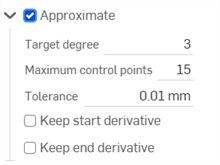
- 최대 제어점 - 선택한 곡선에 허용되는 최대 제어점 수를 입력합니다.
- 허용오차 - 선택한 곡선의 허용오차(길이 측정값) 공차 값을 입력합니다.
- 시작 도함수 유지 - 선택한 곡선의 시작 부분에 탄젠트를 유지하려면 선택합니다.
- 끝 도함수 유지 - 선택한 원곡선의 끝에 탄젠트를 유지하도록 선택합니다.
- 목표 각도 옵션을 열려면상승을 선택합니다. 필요한 경우 선택한 곡선에 대해 더 높은 목표 곡선 각도를 입력합니다. 이는 원하는 각도에 맞추거나, 연결성을 개선하거나, 곡선 모양을 더욱 세밀하게 제어하는 데 유용합니다. 곡선의 기하 구조는 유지됩니다.

- 평면화를 선택하여 참조 평면을 따라 곡선을 직선화하는 옵션을 엽니다. 프로젝트를 평면화하면 제어 곡선이 현재 위치에서 선택한 참조 평면으로 투영됩니다.

참조 면 옵션은 다음과 같습니다.
최적 맞춤 - 모든 제어점 위치의 평균을 사용하여 곡선의 경로와 가장 일치하는 면을 따라 곡선을 투영합니다.
잠금 끝 - 곡선의 끝점이 제자리에 고정되어 있고 움직이지 않는지 확인합니다. 이는 첨부된 지오메트리와의 연속성을 유지하는 데 유용합니다.
YZ 면 - YZ 면(X축에 수직)을 따라 곡선을 투영합니다.
XZ 면 - XZ 면(Y축에 수직)을 따라 곡선을 투영합니다.
XY 면 - XY 면(Z축에 수직)을 따라 곡선을 투영합니다.
사용자 지정 - 사용자 지정 평면 또는 명시적 또는 암시적 메이트 커넥터(Z축에 수직)의 XY 축을 따라 곡선을 투영합니다.
- 제어점 편집을 선택하여 참조를 추가하고 선택한 곡선에서 개별 제어점의 위치와 가중치를 변경할 수 있는 옵션을 엽니다.
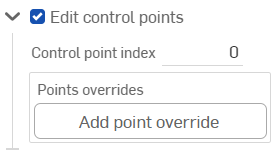
제어점 편집을 체크하면 그래픽 영역에 3축 매니퓰레이터가 표시되고 원점은 첫 번째 제어점(제어점 인덱스 0)에 배치됩니다.
이 제어점 인덱스 필드는 곡선에 있는 점의 최상위 인덱스/ID이며 0부터 시작합니다. 이 필드에 인덱스 번호를 입력하여 각 제어점을 숫자로 선택할 수 있습니다. 이렇게 하면 3축 매니퓰레이터가 그래픽 영역의 해당 제어점으로 이동합니다.
3축 매니퓰레이터는 다음을 조정합니다.
3축에 걸친 선형 이동
3면에 걸친 선형 이동.
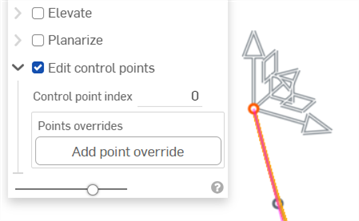
점 재지정 추가 버튼을 클릭하거나 트라이어드 매니퓰레이터를 조정하면 현재 선택한 점에 대한 재정의 옵션이 추가됩니다.
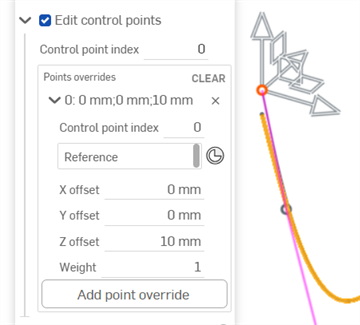
Z축 매니퓰레이터를 10mm 조정하면 현재 제어점(위 이미지의 인덱스 0)에 대한 옵션이 열립니다.
곡선의 각 제어점에 대해 개별적으로 재정의 설정을 추가할 수 있습니다. 점 재지정 추가 버튼을 클릭하여 사용자 지정 재지정 설정을 추가 점에 추가합니다. 각 점에는 한 세트의 재정의 설정만 적용할 수 있습니다.
행 왼쪽에 있는 캐럿(
 )을 눌러 각 행/제어점 재정의를 확장/축소합니다. 각 점의 재정의는 인덱스 번호와 X/Y/Z 오프셋 값을 나열합니다. 각 행의 오른쪽에 있는 x를 클릭하여 해당 지점의 재정의를 지웁니다. 모든 행/제어점 재정의에 대한 모든 재지정 설정을 지우려면 테이블 상단 오른쪽 모서리에 있는 지우기를 클릭합니다.
)을 눌러 각 행/제어점 재정의를 확장/축소합니다. 각 점의 재정의는 인덱스 번호와 X/Y/Z 오프셋 값을 나열합니다. 각 행의 오른쪽에 있는 x를 클릭하여 해당 지점의 재정의를 지웁니다. 모든 행/제어점 재정의에 대한 모든 재지정 설정을 지우려면 테이블 상단 오른쪽 모서리에 있는 지우기를 클릭합니다.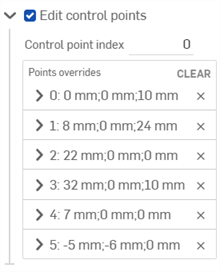
필요한 경우 다음 제어점 재정의 옵션을 각각 편집하십시오.
- 제어점 인덱스 - 재정의되는 제어점의 인덱스입니다.곡선에 있는 점의 색인/ID를 선택합니다. 인덱싱은 0부터 시작합니다.
이 수준에서 제어점 인덱스 번호를 전환하면 현재 점 재지정 설정이 모두 해당 제어점에 적용됩니다. 이러한 방식으로 한 제어점에서 다른 제어점으로 재정의 설정을 즉시 전송할 수 있습니다.
곡선의 각 제어점에 대해 다음 재정의 설정을 편집합니다.
- 참조 - 기본 참조는 변경되지 않은 제어점 위치(3축 매니퓰레이터의 원점)입니다. 꼭지점, 스케치 점 또는 명시적 또는 암시적 메이트 커넥터를 선택하여 현재 점의 X/Y/Z 오프셋 값을 이 점을 기준으로 지정합니다.
제어점을 편집할 때 암시적 메이트 커넥터를 만들려면 메이트 커넥터 선택 아이콘(
 )을 클릭한 다음, 모델에서 위치를 클릭하여 메이트 커넥터를 생성하십시오. 이제 이것이 점 참조로 사용됩니다.
)을 클릭한 다음, 모델에서 위치를 클릭하여 메이트 커넥터를 생성하십시오. 이제 이것이 점 참조로 사용됩니다. - X/Y/Z 오프셋 - 제어점이 기준으로부터 오프셋되어 현재 제어점 위치를 표시합니다. 필요한 경우 각 필드에 숫자 오프셋 값을 입력합니다.
- 가중치 - 곡선을 기준으로 제어점의 가중치를 결정합니다. 가중치 값이 높을수록 곡선이 제어점에 더 가깝게 “당겨집니다”. 가중치 값을 입력하여 곡선에 있는 점의 영향을 해당 양으로 곱합니다.
- 참조 - 기본 참조는 변경되지 않은 제어점 위치(3축 매니퓰레이터의 원점)입니다. 꼭지점, 스케치 점 또는 명시적 또는 암시적 메이트 커넥터를 선택하여 현재 점의 X/Y/Z 오프셋 값을 이 점을 기준으로 지정합니다.
- 점 재정의 추가 - 현재 인덱스가 이미 사용된 경우 인덱스가 현재 선택된 인덱스이거나 배열에서 현재 인덱스 다음으로 사용되지 않은 첫 번째 인덱스가 되도록 새 점 재정의를 테이블에 추가합니다.
- (선택 사항) 기본적으로 세부 정보 표시가 활성화되어 있으며각도값, 제어점수 및스팬수를 읽기 전용으로 표시합니다. 이러한 세부 정보를 숨기려면 이 옵션을 선택 취소하십시오.
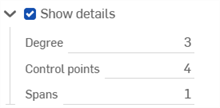
- (선택 사항) 곡선의 근사치가 다시 계산된 경우 편차 표시 확인란을 사용하여 원래 곡선과 근사치가 다시 계산된 곡선 간의 최대 편차를 볼 수 있습니다.

- 체크 표시(
 )를 클릭하여 곡선 편집 피처를 적용합니다.
)를 클릭하여 곡선 편집 피처를 적용합니다.
-
근사치를 사용하기 전(왼쪽)과 사용한 후의 원래 곡선(오른쪽):

-
2개의 접선 스케치 요소에서 새 곡선 생성(왼쪽) 근사치를 사용한 후 단일 곡선으로 결합됩니다(오른쪽). 원본 스케치 요소는 그대로 유지되며 다른 목적으로 계속 사용할 수 있습니다.

-
허용오차 옵션을 사용하여 곡선을 매끄럽게 만들기:
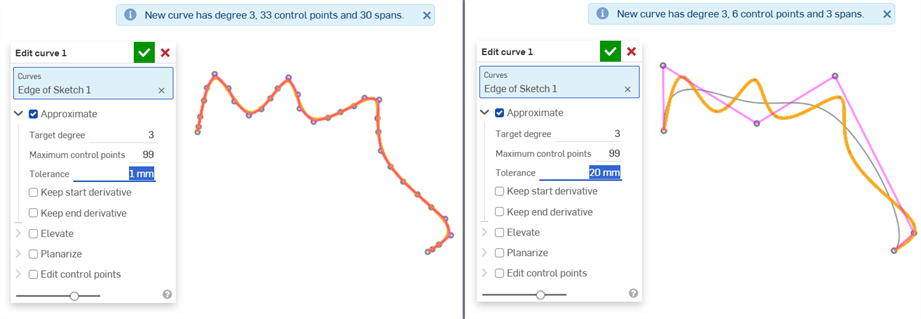
-
목표 각도에 맞게 올리기:
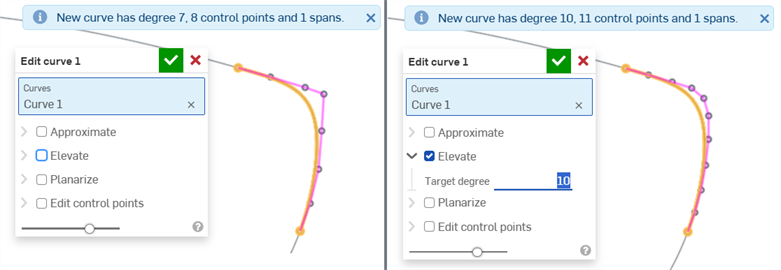
고도가 없고(왼쪽) 목표 각도가 10도까지 올라간 상태(오른쪽)
-
평면화하여 평면을 따라 곡선을 직선으로 만들기:
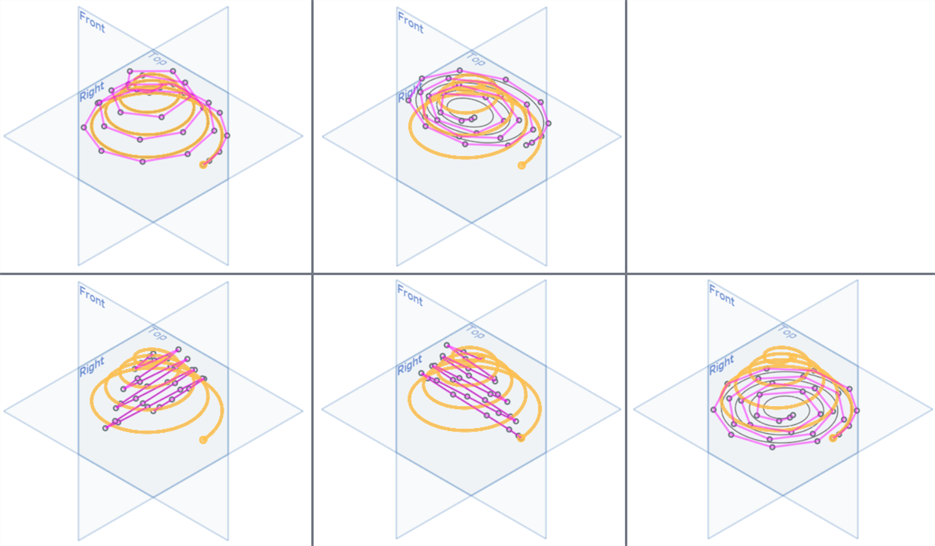
위쪽: 선택하지 않은 상태로 평면화(왼쪽), 최적 맞춤(오른쪽), 아래쪽 왼쪽에서 오른쪽으로: YZ 평면, XZ 평면, XY 평면
-
나선을 나선형으로 평면화하기:
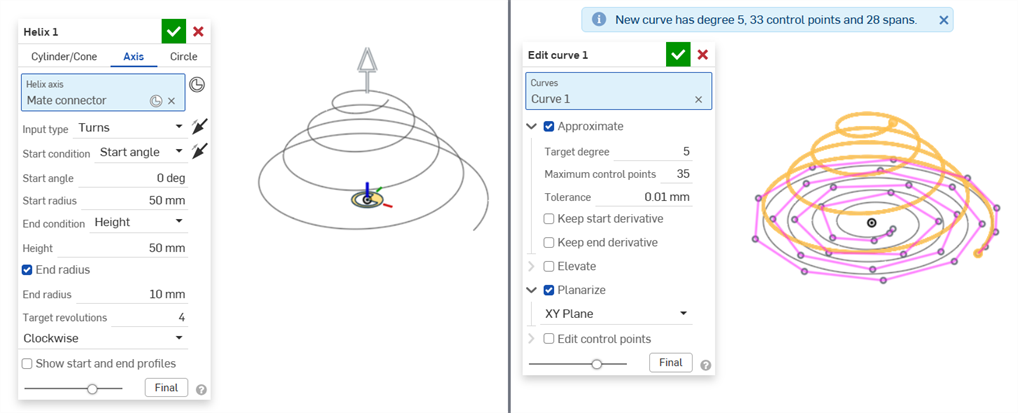
나선 피처(왼쪽), 곡선 편집을 사용하여 나선을 나선형으로 평면화한 후 평면화(오른쪽) >
-
사용자 지정 옵션을 사용하여 평면화하고 메이트 커넥터를 면의 기반으로 선택합니다.

선택하지 않은 상태(왼쪽)와 선택한 상태(오른쪽)를 평면화합니다. 사용자 지정이 선택되고 사용자 지정 평면에 메이트 커넥터가 사용됩니다.
사용자 지정 메이트 커넥터 평면을 사용하여 평면화한 경우 위와 동일한 곡선으로, 다른 평면과 함께 표시됩니다.
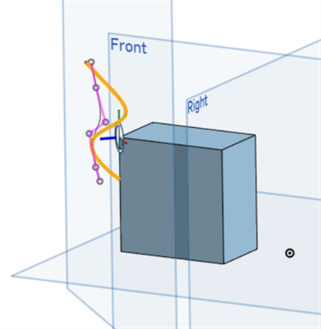
-
곡선을 따라 제어점을 편집하여 모양을 미세 조정합니다.
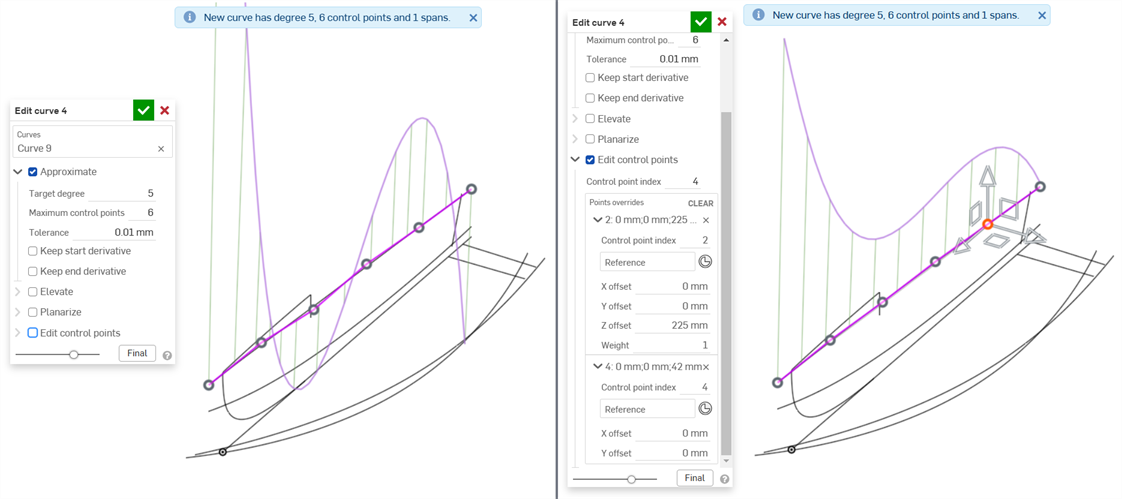
점을 편집하지 않은 원본 곡선(왼쪽)과 보다 부드러운 곡선을 만들기 위해 점 2와 4를 편집한 원본 곡선(오른쪽)
-
제어점을 편집하여 기존 형상을 참조합니다(곡선 외부). 이 방법을 사용하면 참조 형상이 변경되면 곡선이 해당 형상을 따릅니다. 예를 들어 참조된 형상의 크기가 여러 가지이고 이러한 형상을 구성으로 설정하면 어떤 구성을 선택하든 곡선은 항상 형상을 따릅니다.
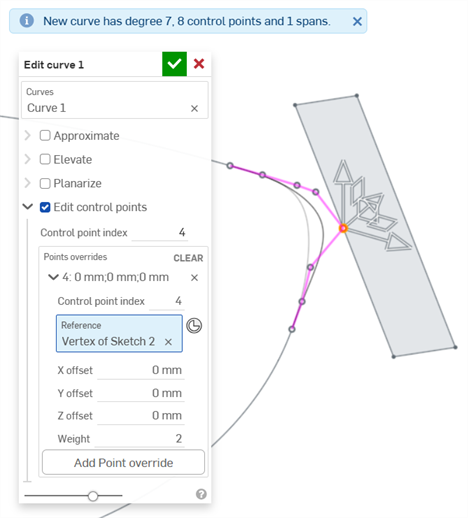
CAD를 가져온 후 곡선이 잘못될 수 있습니다. 설계 프로세스 후반부까지 문제를 알아차리지 못한 채 잘못된 곡선을 사용하여 많은 모델링 작업을 수행한 경우에도 이 문제는 더욱 악화될 수 있습니다.
다음은 가져온 CAD 데이터의 예입니다. 가져오기는 보트에 사용되는 곡선입니다. 곡선/표면 분석 도구를 사용하면 다음 곡선의 문제를 확인할 수 있습니다.
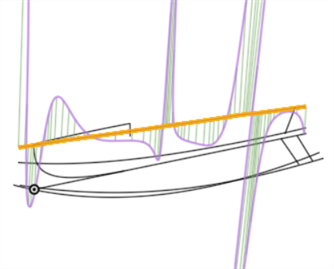
이 곡선에서 표면을 생성하면 잘못 구성된 곡선의 데이터가 설계 프로세스의 다운스트림으로 전달됩니다. 곡선(아래 첫 번째 이미지)을 편집하면 곡선이 더 부드러워집니다(아래 두 번째 이미지). 가져오기 프로세스 후에 바로 곡선을 편집할 수 있으며 곡선을 사용하는 모든 다운스트림 피처가 자동으로 업데이트됩니다.
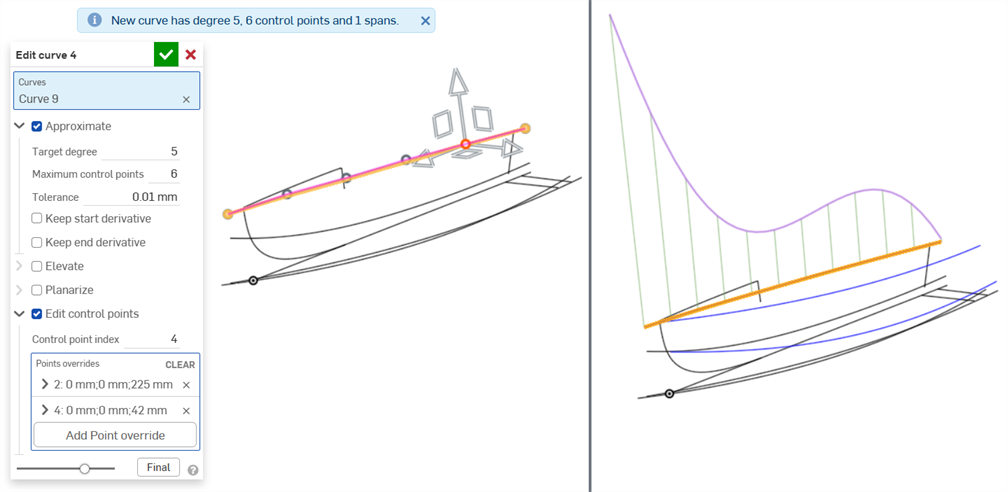
목표 각도에 대한 곡선 근사화: 5; 최대 제어점: 6, 그런 다음 제어점을 편집하여 부드러운 곡선을 만듭니다.
다음은 이전 곡선에서 생성된 다운스트림 피처를 사용한 결과 생성된 경계 표면의 품질 차이를 보여줍니다.
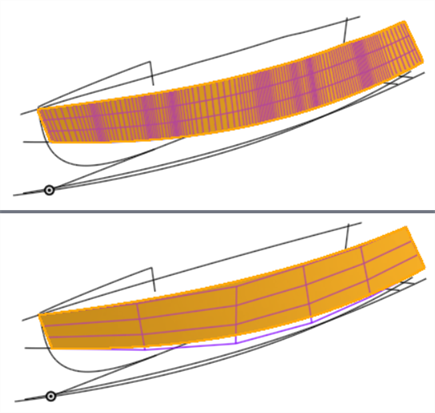
곡선에서 생성된 경계 표면은 문제가 있는 표면(위쪽)을 보여주고 곡선을 편집한 후 품질이 더 좋은 표면(아래쪽)을 보여줍니다. 곡선의 제어점이 적을수록 표면이 더 매끄러워집니다.
-
곡선 편집 옵션을 곡선에 적용할 때는 계층적 순서 또는 작업(종속 순서)이 있습니다. 근사치가 먼저 적용되고, 상승, 평면화, 마지막으로 제어점 편집 순으로 적용됩니다. 곡선의제어점을 편집한 다음평면화를 다음 단계로 수행하려는 경우 두 개의 곡선 편집 피처를 차례로 생성하면 됩니다. 첫 번째 곡선 편집 기능에서 곡선의 제어점을 편집합니다. 그런 다음 두 번째 곡선 편집 기능에서 곡선을 평면화합니다.
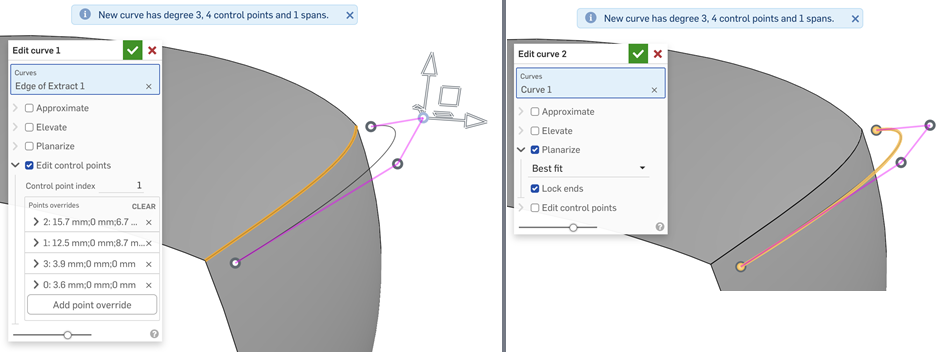
첫 번째 곡선 편집 피처(왼쪽)에서 곡선의 제어점을 편집하고 두 번째 곡선 편집 피처(오른쪽)에서 곡선의 제어점을 평면화하여 곡선에서 수행한 작업의 순서를 반대로 바꿉니다.
-
여러 곡선을 로프트의 기준으로 편집하여 궁극적으로 표면을 만드는 경우 각 곡선에 동일한 양의 제어점이 있는지 확인하십시오. 이렇게 하면 각 곡선의 점 간에 평행성이 유지되어 잘 정의된 로프트가 생성됩니다.
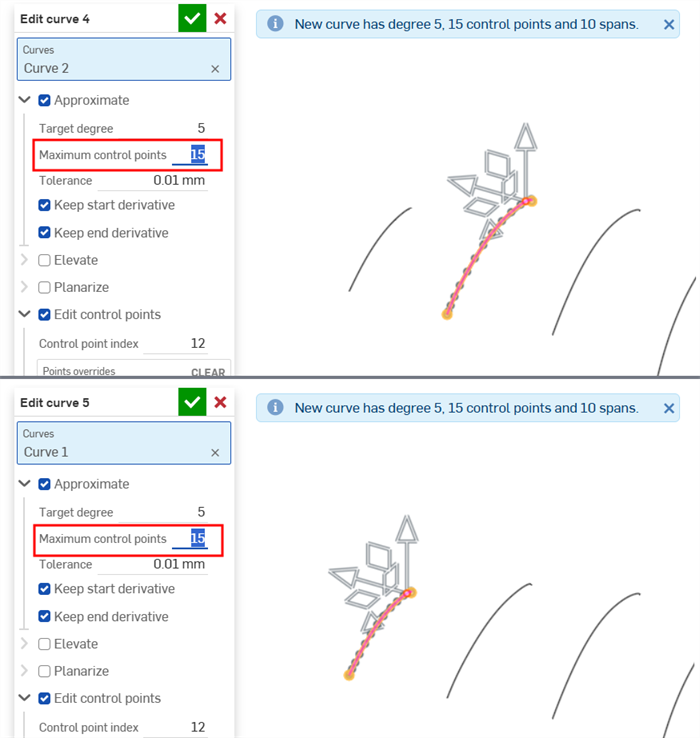
기존 곡선을 편집하거나 스케치 요소 또는 곡선을 선택하여 새 곡선을 생성하여 단순화된 근사치를 적용하고, 차수를 높이고, 제어 곡선 꼭지점을 재배치하거나, 2D 평면으로 평면화합니다.
단계
그래픽 영역에서 사용할 수 있는 선형 스케치 요소 또는 곡선이 하나 이상 있는 경우:
-
곡선 편집 도구 아이콘(
 )을 탭합니다.
)을 탭합니다.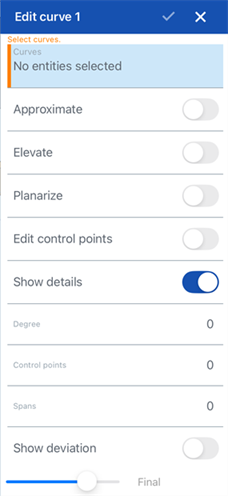
-
그래픽 영역에서 자체 교차하지 않는 하나 이상의 선형 스케치 요소 및/또는 곡선을 선택합니다. 스케치 요소나 곡선은 연속 경로를 따라야 하며, 곡선을 여러 개 선택한 경우 곡선의 근사치를 다시 계산해야 합니다(아래 근사치 체크). 그러면 새 곡선이 생성됩니다.
-
근사치 옆의 토글을 탭하면 곡선의 근사치를 다시 계산할 수 있는 옵션이 열립니다. 원래 곡선은 주황색으로 표시되고 근사치가 다시 계산된 새 곡선은 자홍색으로 표시됩니다. 곡선의 형상을 유지하려는 대략적인 시도이지만, 항상 보장되는 것은 아닙니다.
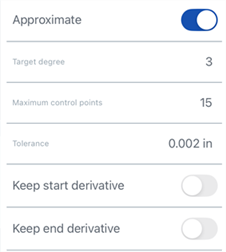
-
목표 각도 - 선택한 곡선의 목표 곡선 각도를 입력합니다.
-
최대 제어점 - 선택한 곡선에 허용되는 최대 제어점 수를 입력합니다.
-
허용오차 - 선택한 곡선의 허용오차(길이 측정값) 공차 값을 입력합니다.
-
시작 도함수 유지 - 선택한 곡선의 시작 부분에서 접선을 유지하려면 켜둡니다.
-
끝 도함수 유지 - 선택한 곡선의 끝부분에서 접선을 유지하려면 켜둡니다.
-
-
상승 옆의 토글을 탭하여 목표 각도 옵션을 엽니다. 필요한 경우 선택한 곡선에 대해 더 높은 목표 곡선 각도를 입력하세요. 이는 원하는 각도에 맞추거나, 연결성을 개선하거나, 곡선 모양을 더욱 세밀하게 제어하는 데 유용합니다. 곡선의 기하 구조는 유지됩니다.
-
평면화 옆의 토글을 탭하면 참조 평면을 따라 곡선을 직선화하는 옵션이 열립니다. 평면화는 제어 곡선을 현재 위치에서 선택한 참조 평면으로 투영합니다.
참조 면 옵션은 다음과 같습니다.
-
최적 맞춤 - 모든 제어점 위치의 평균을 사용하여 곡선의 경로와 가장 일치하는 면을 따라 곡선을 투영합니다.
-
잠금 끝 - 곡선의 끝점이 제자리에 고정되어 있고 움직이지 않도록 하려면 이 옵션을 켜둡니다. 확인합니다. 이는 연결된 지오메트리와의 연속성을 유지하는 데 유용합니다.
-
YZ 면 - YZ 면(X축에 수직)을 따라 곡선을 투영합니다.
-
XZ 면 - XZ 면(Y축에 수직)을 따라 곡선을 투영합니다.
-
XY 면 - XY 면(Z축에 수직)을 따라 곡선을 투영합니다.
-
사용자 지정 - 사용자 지정 평면 또는 명시적 또는 암시적 메이트 커넥터(Z축에 수직)의 XY 축을 따라 곡선을 투영합니다.
-
-
제어점 편집을 탭하여 참조를 추가하고 선택한 곡선에서 개별 제어점의 위치와 가중치를 변경할 수 있는 옵션을 엽니다.
제어점 편집을 토글하면 그래픽 영역에 3축 매니퓰레이터가 표시되고 원점은 첫 번째 제어점(제어점 인덱스 0)에 배치됩니다.
이 제어점 인덱스 필드는 곡선에 있는 점의 최상위 인덱스/ID이며 0부터 시작합니다. 이 필드에 인덱스 번호를 입력하여 각 제어점을 숫자로 선택할 수 있습니다. 이렇게 하면 3축 매니퓰레이터가 그래픽 영역의 해당 제어점으로 이동합니다.
곡선의 각 제어점에 대해 개별적으로 재지정 설정을 추가할 수 있습니다. 대화상자의점 재정의 섹션에 있는점 재정의 추가 버튼 을 눌러 사용자 지정 재정의 설정을 추가 점에 추가합니다. 각 점에는 한 세트의 재정의 설정만 적용할 수 있습니다. 점 재지정 추가 옵션을 선택하거나 3축 매니퓰레이터터를 조정하면 현재 선택한 점에 대한 재지정 옵션이 추가됩니다.
행 왼쪽에 있는 캐럿(
 )을 눌러 각 행/제어점 재정의를 확장하거나 축소할 수 있습니다. 각 점의 재정의는 인덱스 번호와 X/Y/Z 오프셋 값을 나열합니다.
)을 눌러 각 행/제어점 재정의를 확장하거나 축소할 수 있습니다. 각 점의 재정의는 인덱스 번호와 X/Y/Z 오프셋 값을 나열합니다.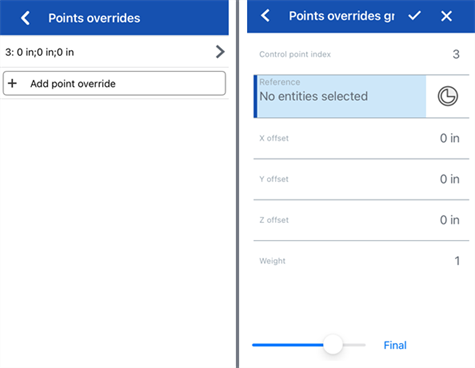
왼쪽으로 살짝 밀고 삭제 버튼을 탭하면 해당 점의 재정의가 지워집니다.
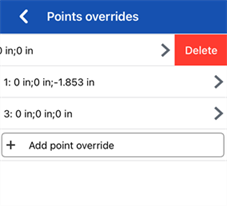
필요한 경우 다음 제어점 재정의 옵션을 각각 편집하십시오.
-
제어점 인덱스- 재지정되는 제어점의 인덱스입니다. 곡선 위 점의 인덱스/ID를 선택합니다. 인덱싱은 0부터 시작합니다.
이 레벨에서 제어점 인덱스 번호를 전환하면 현재 모든 제어점 재지정 설정이 해당 제어점에 적용됩니다. 이렇게 하면 재지정 설정을 한 제어점에서 다른 제어점으로 즉시 전송할 수 있습니다.
곡선의 각 제어점에 대해 다음 재정의 설정을 편집합니다.
-
참조 - 기본 참조는 변경되지 않은 제어점 위치(3축 매니퓰레이터의 원점) 입니다. 꼭지점, 스케치 점 또는 명시적 또는 암시적 메이트 커넥터를 선택하여 현재 점의 X/Y/Z 오프셋 값을 이 점을 기준으로 지정합니다.
제어점을 편집할 때 암시적 메이트 커넥터를 만들려면 메이트 커넥터 선택 아이콘을 누른 다음 모델에서 위치를 눌러 메이트 커넥터를 생성합니다. 이제 이것이 점 참조로 사용됩니다.
-
X/Y/Z 오프셋 - 제어점이 기준으로부터 오프셋되어 현재 제어점 위치를 표시합니다. 필요한 경우 각 필드에 숫자 오프셋 값을 입력합니다.
-
가중치 - 곡선을 기준으로 제어점의 가중치를 결정합니다. 가중치 값이 높을수록 곡선이 제어점에 더 가깝게 당겨집니다. 가중치 값을 입력하여 곡선에 있는 점의 영향을 해당 양으로 곱합니다.
-
-
점 재정의 추가 - 현재 인덱스가 이미 사용된 경우 인덱스가 현재 선택된 인덱스이거나 배열에서 현재 인덱스 다음으로 사용되지 않은 첫 번째 인덱스가 되도록 새 점 재정의를 테이블에 추가합니다.
-
-
(선택 사항) 기본적으로 세부 정보 표시가 활성화되어 있으며각도값, 제어점수 및스팬수를 읽기 전용으로 표시합니다. 이러한 세부 정보를 숨기려면 이 옵션을 끄십시오.
-
(선택 사항) 곡선의 근사치가 다시 계산된 경우, 편차 표시 옵션을 전환하여 원래 곡선과 근사치가 다시 계산된 곡선 간의 최대 편차를 볼 수 있습니다.
-
대화상자 상단에 있는 체크표시를 눌러 편집한 곡선을 적용하고 대화상자를 닫습니다.
기존 곡선을 편집하거나 스케치 요소 또는 곡선을 선택하여 새 곡선을 생성하여 단순화된 근사치를 적용하고, 차수를 높이고, 제어 곡선 꼭지점을 재배치하거나, 2D 평면으로 평면화합니다.
단계
그래픽 영역에서 사용할 수 있는 선형 스케치 요소 또는 곡선이 하나 이상 있는 경우:
-
곡선 편집 도구 아이콘(
 )을 탭합니다.
)을 탭합니다.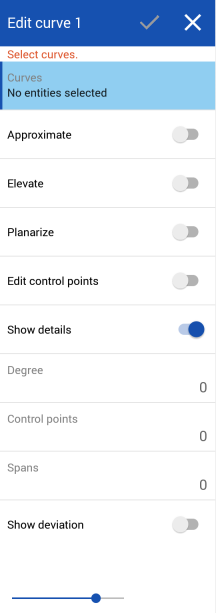
-
그래픽 영역에서 자체 교차하지 않는 하나 이상의 선형 스케치 요소 및/또는 곡선을 선택합니다. 스케치 요소나 곡선은 연속 경로를 따라야 하며, 곡선을 여러 개 선택한 경우 곡선의 근사치를 다시 계산해야 합니다(아래 근사치 체크). 그러면 새 곡선이 생성됩니다.
-
근사치 옆의 토글을 탭하면 곡선의 근사치를 다시 계산할 수 있는 옵션이 열립니다. 원래 곡선은 주황색으로 표시되고 근사치가 다시 계산된 새 곡선은 자홍색으로 표시됩니다. 곡선의 형상을 유지하려는 대략적인 시도이지만, 항상 보장되는 것은 아닙니다.
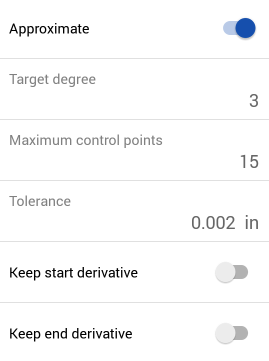
-
목표 각도 - 선택한 곡선의 목표 곡선 각도를 입력합니다.
-
최대 제어점 - 선택한 곡선에 허용되는 최대 제어점 수를 입력합니다.
-
허용오차 - 선택한 곡선의 허용오차(길이 측정값) 공차 값을 입력합니다.
-
시작 도함수 유지 - 선택한 곡선의 시작 부분에서 접선을 유지하려면 켜둡니다.
-
끝 도함수 유지 - 선택한 곡선의 끝부분에서 접선을 유지하려면 켜둡니다.
-
-
상승 옆의 토글을 탭하여 목표 각도 옵션을 엽니다. 필요한 경우 선택한 곡선에 대해 더 높은 목표 곡선 각도를 입력하세요. 이는 원하는 각도에 맞추거나, 연결성을 개선하거나, 곡선 모양을 더욱 세밀하게 제어하는 데 유용합니다. 곡선의 기하 구조는 유지됩니다.
-
평면화 옆의 토글을 탭하면 참조 평면을 따라 곡선을 직선화하는 옵션이 열립니다. 평면화는 제어 곡선을 현재 위치에서 선택한 참조 평면으로 투영합니다.
참조 면 옵션은 다음과 같습니다.
-
최적 맞춤 - 모든 제어점 위치의 평균을 사용하여 곡선의 경로와 가장 일치하는 면을 따라 곡선을 투영합니다.
-
잠금 끝 - 곡선의 끝점이 제자리에 고정되어 있고 움직이지 않도록 하려면 이 옵션을 켜둡니다. 확인합니다. 이는 연결된 지오메트리와의 연속성을 유지하는 데 유용합니다.
-
YZ 면 - YZ 면(X축에 수직)을 따라 곡선을 투영합니다.
-
XZ 면 - XZ 면(Y축에 수직)을 따라 곡선을 투영합니다.
-
XY 면 - XY 면(Z축에 수직)을 따라 곡선을 투영합니다.
-
사용자 지정 - 사용자 지정 평면 또는 명시적 또는 암시적 메이트 커넥터(Z축에 수직)의 XY 축을 따라 곡선을 투영합니다.
-
-
제어점 편집을 탭하여 참조를 추가하고 선택한 곡선에서 개별 제어점의 위치와 가중치를 변경할 수 있는 옵션을 엽니다.
제어점 편집을 토글하면 그래픽 영역에 3축 매니퓰레이터가 표시되고 원점은 첫 번째 제어점(제어점 인덱스 0)에 배치됩니다.
이 제어점 인덱스 필드는 곡선에 있는 점의 최상위 인덱스/ID이며 0부터 시작합니다. 이 필드에 인덱스 번호를 입력하여 각 제어점을 숫자로 선택할 수 있습니다. 이렇게 하면 3축 매니퓰레이터가 그래픽 영역의 해당 제어점으로 이동합니다.
곡선의 각 제어점에 대해 개별적으로 재지정 설정을 추가할 수 있습니다. 대화상자의점 재정의 섹션에 있는점 재정의 추가 버튼 을 눌러 사용자 지정 재정의 설정을 추가 점에 추가합니다. 각 점에는 한 세트의 재정의 설정만 적용할 수 있습니다. 점 재지정 추가 옵션을 선택하거나 3축 매니퓰레이터터를 조정하면 현재 선택한 점에 대한 재지정 옵션이 추가됩니다.
행/제어점 재지정을 확장하거나 축소하려면 행 왼쪽의 캐럿(
 )을 누릅니다. 각 지점의 재지정은 인덱스 번호와 X/Y/Z 오프셋 값을 나열합니다. 각 행 오른쪽의 빨간색 x를 탭하면 해당 지점의 재지정이 해제됩니다.
)을 누릅니다. 각 지점의 재지정은 인덱스 번호와 X/Y/Z 오프셋 값을 나열합니다. 각 행 오른쪽의 빨간색 x를 탭하면 해당 지점의 재지정이 해제됩니다.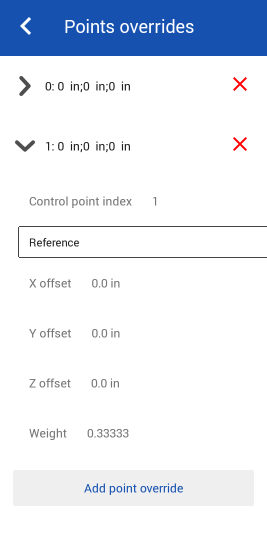
필요한 경우 다음 제어점 재정의 옵션을 각각 편집하십시오.
-
제어점 인덱스- 재지정되는 제어점의 인덱스입니다. 곡선 위 점의 인덱스/ID를 선택합니다. 인덱싱은 0부터 시작합니다.
이 레벨에서 제어점 인덱스 번호를 전환하면 현재 모든 제어점 재지정 설정이 해당 제어점에 적용됩니다. 이렇게 하면 재지정 설정을 한 제어점에서 다른 제어점으로 즉시 전송할 수 있습니다.
곡선의 각 제어점에 대해 다음 재정의 설정을 편집합니다.
-
참조 - 기본 참조는 변경되지 않은 제어점 위치(3축 매니퓰레이터의 원점) 입니다. 꼭지점, 스케치 점 또는 명시적 또는 암시적 메이트 커넥터를 선택하여 현재 점의 X/Y/Z 오프셋 값을 이 점을 기준으로 지정합니다.
제어점을 편집할 때 암시적 메이트 커넥터를 만들려면 메이트 커넥터 선택 아이콘을 누른 다음 모델에서 위치를 눌러 메이트 커넥터를 생성합니다. 이제 이것이 점 참조로 사용됩니다.
-
X/Y/Z 오프셋 - 제어점이 기준으로부터 오프셋되어 현재 제어점 위치를 표시합니다. 필요한 경우 각 필드에 숫자 오프셋 값을 입력합니다.
-
가중치 - 곡선을 기준으로 제어점의 가중치를 결정합니다. 가중치 값이 높을수록 곡선이 제어점에 더 가깝게 당겨집니다. 가중치 값을 입력하여 곡선에 있는 점의 영향을 해당 양으로 곱합니다.
-
-
점 재정의 추가 - 현재 인덱스가 이미 사용된 경우 인덱스가 현재 선택된 인덱스이거나 배열에서 현재 인덱스 다음으로 사용되지 않은 첫 번째 인덱스가 되도록 새 점 재정의를 테이블에 추가합니다.
-
-
(선택 사항) 기본적으로 세부 정보 표시가 활성화되어 있으며각도값, 제어점수 및스팬수를 읽기 전용으로 표시합니다. 이러한 세부 정보를 숨기려면 이 옵션을 끄십시오.
-
(선택 사항) 곡선의 근사치가 다시 계산된 경우, 편차 표시 옵션을 전환하여 원래 곡선과 근사치가 다시 계산된 곡선 간의 최대 편차를 볼 수 있습니다.
-
대화상자 상단에 있는 체크표시를 눌러 편집한 곡선을 적용하고 대화상자를 닫습니다.
곡선은 표면 처리 도구 외에도 표면의 기본 구성 요소를 만드는 데 사용됩니다.
여기에는 커브 피처 툴 컬렉션이 나열되어 있습니다.이 목록은 전체 목록이 아닙니다. 곡선을 조작할 때 추가 피처 도구를 사용할 수 있습니다.
- 스케치 도구 - 선, 모서리 직사각형, 중심점 직사각형, 중심점 원, 3점 원, 접선 호, 3점 호, 스플라인, 점 및 Part Studio에서 스케치를 작성하는 데 사용되는 구성 등과 같은 스케치 툴바의 도구입니다.
-
 나선 - 원추형 또는 원통형 면, 메이트 커넥터의 단일 축 또는 z축 또는 원형 모서리를 사용하여 나선을 생성합니다.
나선 - 원추형 또는 원통형 면, 메이트 커넥터의 단일 축 또는 z축 또는 원형 모서리를 사용하여 나선을 생성합니다. -
 3D 맞춤 스플라인 - 일련의 정점을 통해 3D 맞춤 스플라인을 작성합니다. 곡선을 생성합니다. 이 곡선은 파트 목록의 곡선 아래에 나열됩니다.
3D 맞춤 스플라인 - 일련의 정점을 통해 3D 맞춤 스플라인을 작성합니다. 곡선을 생성합니다. 이 곡선은 파트 목록의 곡선 아래에 나열됩니다. -
 투영된 곡선 - 두 스케치를 투영하여(두 스케치 옵션) 또는 면에 곡선을 투영(곡선과 면 사이 옵션)하여 곡선을 생성합니다.
투영된 곡선 - 두 스케치를 투영하여(두 스케치 옵션) 또는 면에 곡선을 투영(곡선과 면 사이 옵션)하여 곡선을 생성합니다. -
 브리징 커브 - 두 점, 꼭지점 또는 메이트 커넥터를 연결하는 곡선을 만듭니다. 결과 곡선은 피처 리스트과 파트 목록에 나열됩니다.
브리징 커브 - 두 점, 꼭지점 또는 메이트 커넥터를 연결하는 곡선을 만듭니다. 결과 곡선은 피처 리스트과 파트 목록에 나열됩니다. -
 복합 곡선 - 여러 모서리를 하나의 곡선으로 표시합니다. 인접한 모서리, 스케치 요소 및 기타 곡선을 여러 개 선택합니다. 인접하지 않은 모서리를 선택하면 커브가 여러 개 생성될 수 있습니다. 각 커브에 대한 선택은 해당 버텍스에서 만나야 합니다. (곡선은 파트 > 곡선 목록에 나열됩니다.)
복합 곡선 - 여러 모서리를 하나의 곡선으로 표시합니다. 인접한 모서리, 스케치 요소 및 기타 곡선을 여러 개 선택합니다. 인접하지 않은 모서리를 선택하면 커브가 여러 개 생성될 수 있습니다. 각 커브에 대한 선택은 해당 버텍스에서 만나야 합니다. (곡선은 파트 > 곡선 목록에 나열됩니다.) -
 교차 곡선 - 두 개 이상의 표면 또는 면이 교차하는 지점에 곡선을 생성합니다. 선택 항목이 교차해야 합니다.
교차 곡선 - 두 개 이상의 표면 또는 면이 교차하는 지점에 곡선을 생성합니다. 선택 항목이 교차해야 합니다. -
 커브 자르기 - 거리나 경계 요소까지 커브를 자르거나 연장합니다.
커브 자르기 - 거리나 경계 요소까지 커브를 자르거나 연장합니다. -
 등경사선 - 경사면에 등경사선을 생성합니다. 등경사선은 면의 참조 정의에 비해 일정한 경사가 있는 위치의 면을 따라 이어집니다. 결과 등경사선은 피처 리스트과 파트 목록에 나열됩니다.
등경사선 - 경사면에 등경사선을 생성합니다. 등경사선은 면의 참조 정의에 비해 일정한 경사가 있는 위치의 면을 따라 이어집니다. 결과 등경사선은 피처 리스트과 파트 목록에 나열됩니다. -
 오프셋 커브 - 주변 면의 모서리를 오프셋하여 새 커브를 생성, 확장 및/또는 분할합니다.
오프셋 커브 - 주변 면의 모서리를 오프셋하여 새 커브를 생성, 확장 및/또는 분할합니다. -
 아이소파라메트릭 커브 - 면이나 표면을 따라 U 또는 V 방향으로 이어지는 부드러운 곡선을 만듭니다.
아이소파라메트릭 커브 - 면이나 표면을 따라 U 또는 V 방향으로 이어지는 부드러운 곡선을 만듭니다. -
 곡선 편집 - 스케치 요소나 곡선을 선택하여 기존 곡선을 편집하여 단순화된 근사치를 적용하고, 차수를 높이고, 제어 곡선 꼭지점을 재배치하거나, 2D 평면으로 평면화합니다.
곡선 편집 - 스케치 요소나 곡선을 선택하여 기존 곡선을 편집하여 단순화된 근사치를 적용하고, 차수를 높이고, 제어 곡선 꼭지점을 재배치하거나, 2D 평면으로 평면화합니다. -
 라우팅 곡선 - 3D 공간(라우팅 경로)에서 하나 이상의 평면을 가로지르는 다중점 곡선을 만듭니다. 이는 고급 표면 처리를 위한 파이프 라우팅, 와이어링 및 NURBS 곡선을 작성하는 데 유용합니다.
라우팅 곡선 - 3D 공간(라우팅 경로)에서 하나 이상의 평면을 가로지르는 다중점 곡선을 만듭니다. 이는 고급 표면 처리를 위한 파이프 라우팅, 와이어링 및 NURBS 곡선을 작성하는 데 유용합니다.